When you were a child, did you ever have one of those conversations with friends like “in my perfect world, I’d make sure there was _____”? Maybe it was a grade school project where you had to write a report on what you hoped life on the moon would be like in fifty years. Fun little thought experiments where you debated with friends about if it would be cooler to have personal jetpacks or the ability to have people live underwater.
It might sound bizarre, but playing It’s A Wonderful World had me feeling like I was revisiting those conversations as an adult. In my third turn, I’d feel like I had just managed a huge victory by discovering a way to turn lead into gold. Then my friend would snicker and reveal the fact that he had just managed to invent a universal vaccine for all illnesses… then we would both turn our heads as another friend grinned, slapping down a card proving he had found out how to explore parallel dimensions.
Let me back up a bit: It’s A Wonderful World is a game that will surprise you. It’s got card drafting, engine building, resource acquisition, and it manages to stuff a lot of mechanics into a surprisingly small and simple package. It’s a really good game with some great art, and while I’m not sure if it's for everyone, it has a charm about it that I wish more board games managed to capture.
**Editor's Note: This Game was given to us as a review copy way back at the end of 2019. We loved it, played it at game night for months... up until the COVID 19 shut down. We thought the article we had written was published, but in the chaos of 2020, it stayed buried in drafts. Years later, I still think the game is great, and stays in my personal collection, getting played occasionally, and is still worth talking about. Without further ado, the review!
Build Your Own Empire, In One Hour Or Less!
The game itself has a very basic premise with very basic rules: what if you had the chance to build a futuristic civilization? What would you prioritize? What great wonders would you try and accomplish? Of course, there are other players trying to do the same thing at the same time, as quick: do you prioritize science? Wealth? Discovering Atlantis?
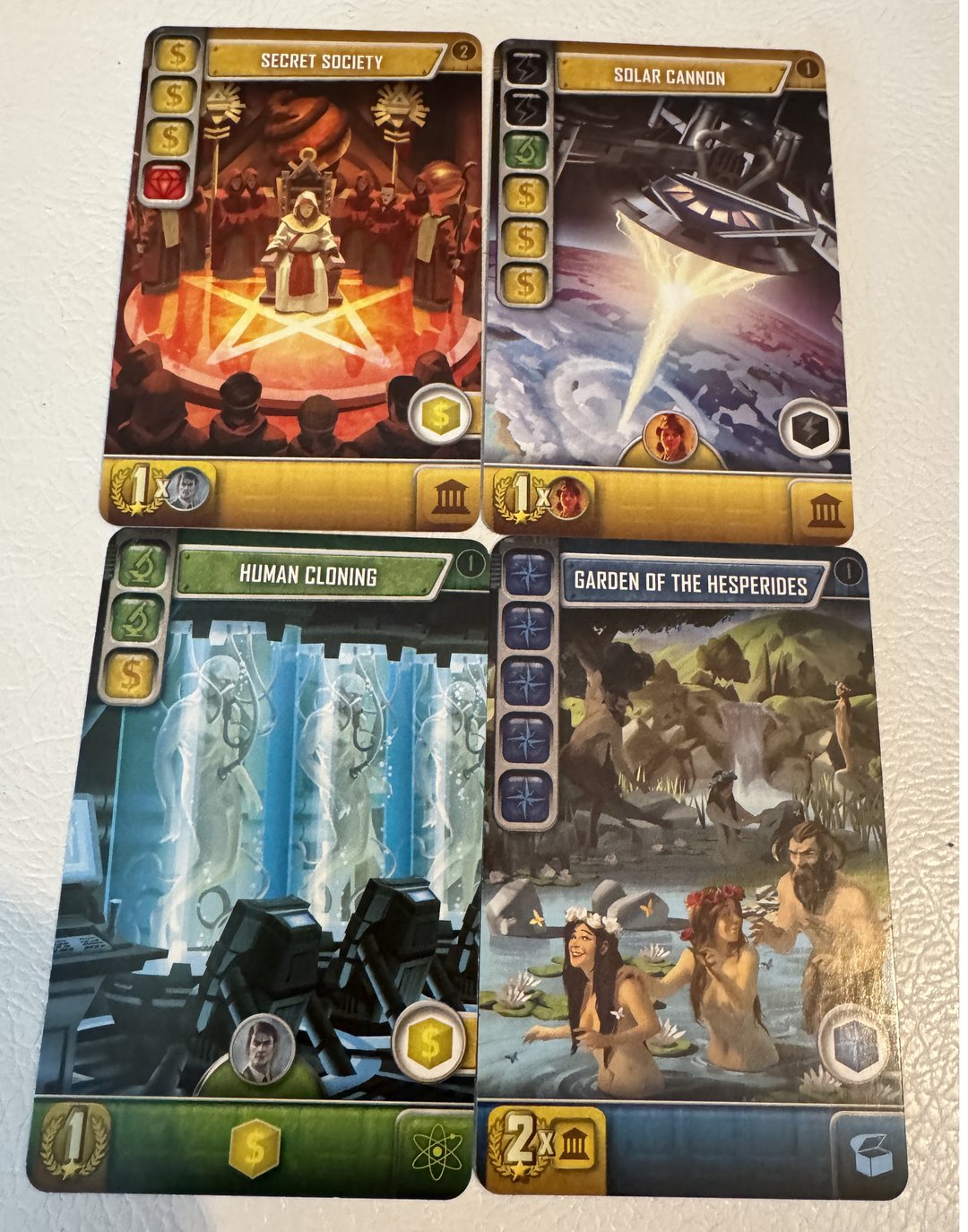
I just enjoy that all of these are viable options towards winning.
This premise plays out over only four rounds, with there being three major phases to each round:
- Draft Phase: Get your 7 development cards for that round! These are the schematics and plans for your empire you might choose to build.
- Planning Phase: this is the moment in the round where you choose whether to turn your 6 development cards into raw materials or place them down as projects to complete
- Production Phase: This is the meat and potatoes, where the projects you’ve already built produce the resources you need to complete other projects on your to do list.
After four turns, the game is over. Whoever has the most points wins. Simple, right?
Seize The Means of Production
Even if it’s quick to explain, It’s not that easy to make happen. I feel like It’s A Wonderful World nails that elusive goal of being easy to explain the basics to, while still having a lot of complexity. For anyone that’s played Magic: The Gathering or other card games, the draft phase is a quick sell. The planning phase can come with some analysis paralysis, where you have to decide which of your draft cards are actually possible to accomplish, but the production phase… that’s where this game makes or breaks you.
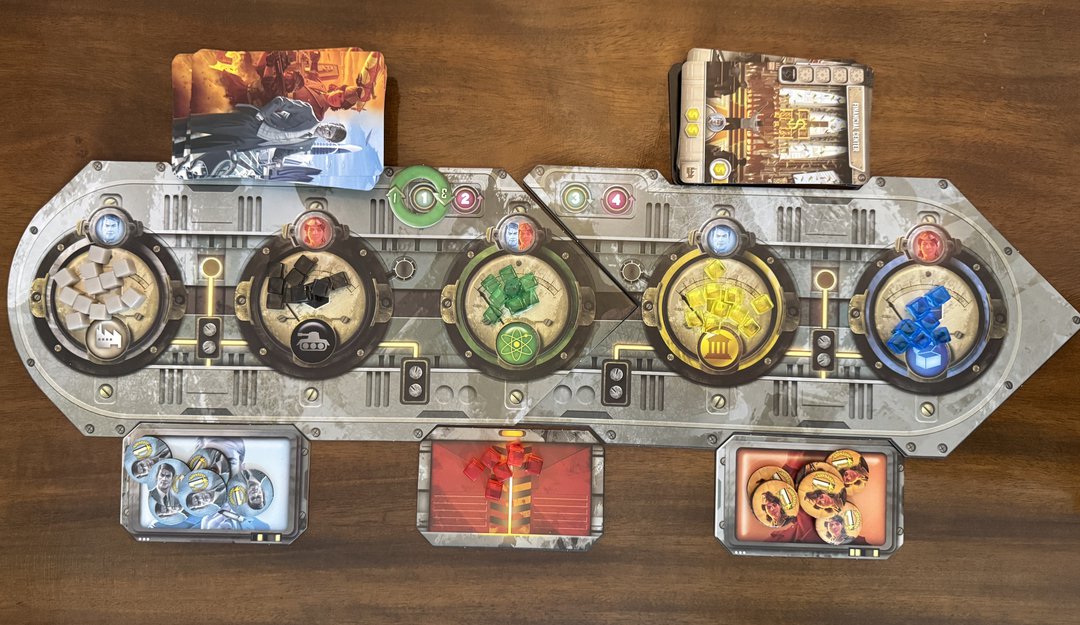
An up-close look at the board. You can see the 5 major resource cubes, and they handily show the order the production phase works in.
There are five basic resources you are trying to collect in the form of colored cubes (plus an additional bright red cube that counts as a wild): materials, energy, science, gold, and exploration. Different resources isn’t anything new, but the trick here is that you don’t collect them all at the same time. Instead, you go in the order above. First you collect material cubes, then energy, and so on.
Why does the order matter? Well, the cards you are producing each need a different amount of resources to be created, and if you can finish building projects in time, they can give you their resources the same turn you build them. For example, managing to finish the ‘Transmutation’ science card before the gold production triggers means you’ll get three yellow cubes the same turn, rather than having to wait.
This can create a very, very addicting chain reaction. I’ve seen players during the planning phase rearranging the cards in front of them while doing mental math, muttering to themselves as they don’t only decide what buildings they want to create, but in what order. If you get it right, you being able to build a power plant early in the turn might allow you to discover Atlantis later. Being ruthless and destroying a favorite card for its spare resource might allow you to win by building something else.
Points, Points Everywhere!
Another thing I enjoy about It’s A Wonderful World is the victory point system. It isn’t complex or revolutionary, but instead absolutely tries to drown players in rivers of serotonin. Every card in the game awards players something as long as you get it built. Only the most common cards don’t give victory points, and that’s because they are stepping stools to get the resources to build bigger and better things.
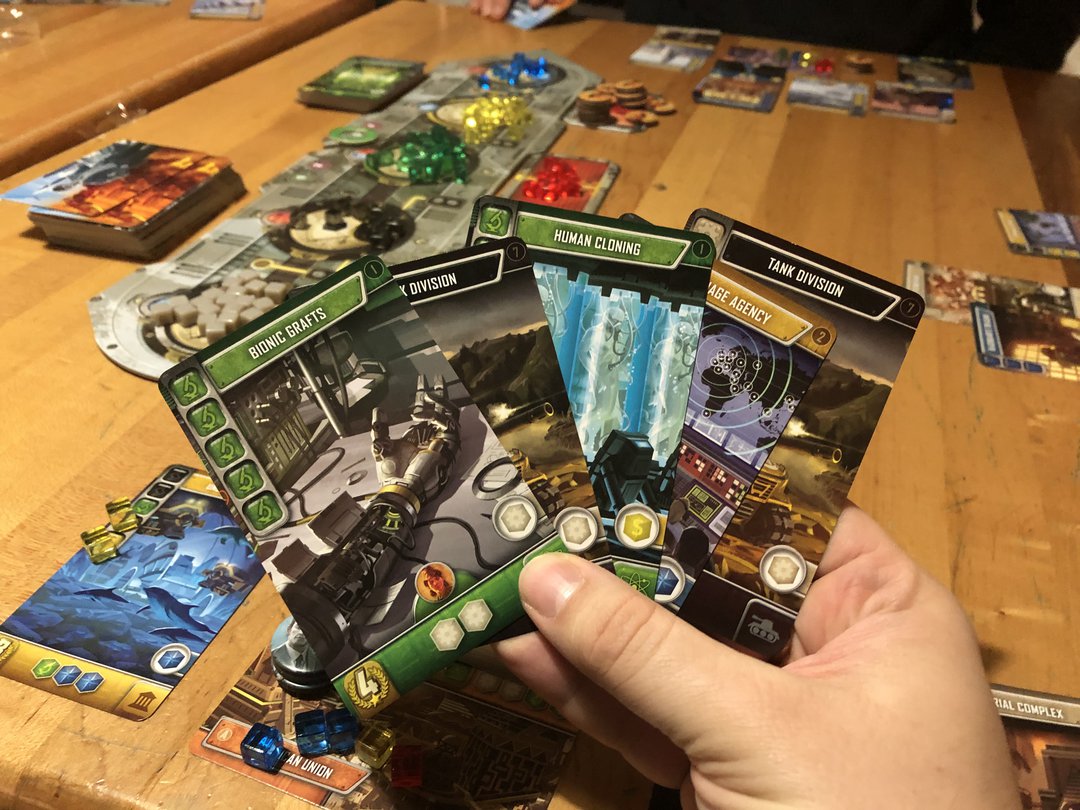
Did you manage to collect enough science in order to invent Teleportation? Congratulations, you get a whopping 8 points! Did you manage to build just… a giant freaking tower that’s taller than the clouds using lots of money? 10 points! Dug up the Ark of the Covenant? 5 points!
Meanwhile, there are cards that seem very expensive and not like they are worth a lot, but that’s because of how they help you generate more cubes every turn. Creating Climate Control domes is a paltry 2 victory points, but generates two military and one money cube a turn, so if you are trying to build projects of that type, it’s very beneficial to get this project finished quickly.
Finally, you have point multiplier cards, ones that really emphasize the game’s focus on risk/reward. For nearly the same cost as the Teleportation card, I can instead invent Super Soldiers. It only earns me one victory point… but it’s one victory point per commander I have collected. If I’ve focused heavily on collecting commanders, each of which is worth one victory point on its own… well, you get the picture. It's a risky approach that relies on you being able to collect and build in a particular way, but it can pay off wonderfully.
Solitaire Rule
I would also like to note that It’s A Wonderful World really excels as a Solo game. While many games now have a solo mode, the size of the cards and how you set up your playing area really gives you a Solitaire feel. It was easy to set up, shuffle and play multiple rounds in a row. Because the game is so point heavy, solo games still have a feeling of accomplishment even if you don’t succeed based on the point totals they suggest in the manual. There’s very much a sense of “My high score so far has been 62... but what if I can make it to 70?”
 It's A Wonderful World
It's A Wonderful World
Designer: Frédéric Guérard
Publisher: Lucky Duck Games
Format: Card Game, Board Game
Number of Players: 1-5
Play Time: 30-60 Minutes
Price: $50
Review Copy: This game was played with a review copy given by the publisher.
In addition, the game manual actually takes some time to give solo players a few scenarios, adding variety. I really enjoy this, where the game tells you to add particular cards to your construction area, declaring that you cannot win unless those in particular are built. It forces you to change tactics and try out new strategies to get them constructed in time and make the point goals to earn medals. Like much of this game, I love how wacky it gets: who doesn’t want to be told “go figure out time travel for me, and make it snappy?”
Problems?
There are a few small issues to quickly talk about, the first probably being the board itself: I like that it's not a standard square, but how it all fits together as a small puzzle feels unnecessarily fiddly. When you are putting stacks of cubes and point tokens on this small board that is in pieces and can be jostled, you sometimes wish you had a more sturdy board. Honestly, if this game board had recessed edges to keep the cubes in place, it would have a perfect design.
Secondly, even though the box itself is nice and small and it's easy to pack away, just be aware that you’ll probably need more table space than you’d expect for each player. Sometimes in the third round, you’ll see people with six or more projects spread out in front of them, with a giant stack of already created cards fanned out to keep track of all their bonuses. It’s not a big problem, but something to be aware of - knocking a small table when everyone is carefully stacking cubes while planning construction can be frustrating.
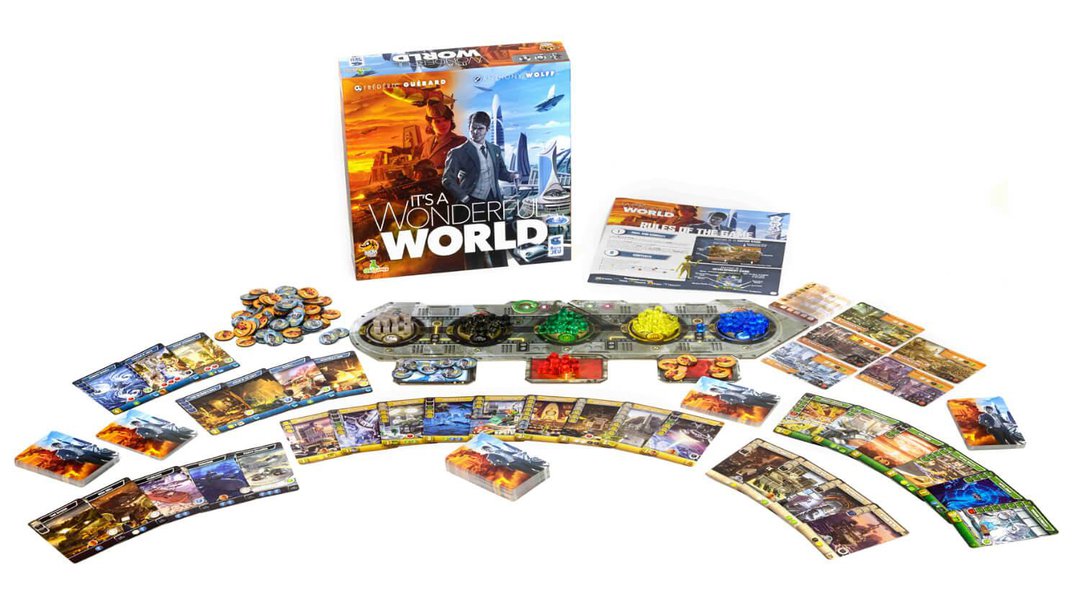
It's a good game that fits in a medium sixed box, but your table getting bumped and seeing your cubes scatter WILL make you scream.
Finally, I find It’s A Wonderful World to be a great solo game or 3-5 player game, but it’s not for two players. While the deck of cards is absolutely stuffed with combos and points, with just two players the luck of the draw can be felt. If someone manages to pull a strong hand early and get set up with a point multiplier, and the other player doesn’t pull a similar card, it can feel one sided. With three or more players, there are just more cards being drawn, and more chances to pass around a winning hand of cards for people to share the wealth with.
World Building Fun For Everyone
Currently sitting at 50 dollars retail, It’s A Wonderful World is worth the cost. It’s got a lot going for it, managing to balance being an easy game to pick up while also having a lot of great decision making. This is a game of deciding between good actions and great actions; everyone feels good as they rack up their victory points for posterity, but people who enjoy the game will begin to recognize how one different card draft could have vaulted them into first place.
This is also a fast game, with a majority of my 20+ times playing taking place in less than an hour. Drafting is fun and keeps the game moving, and with there only being four full rounds, you don’t get stuck spending a long time ‘engine building’ the perfect set of buildings. In fact, I often lost when I got greedy trying to set up for perfect plays while someone else just went for points. This is a game that doesn’t outstay its welcome, feeling punchy while still giving analytical players something to chew on.
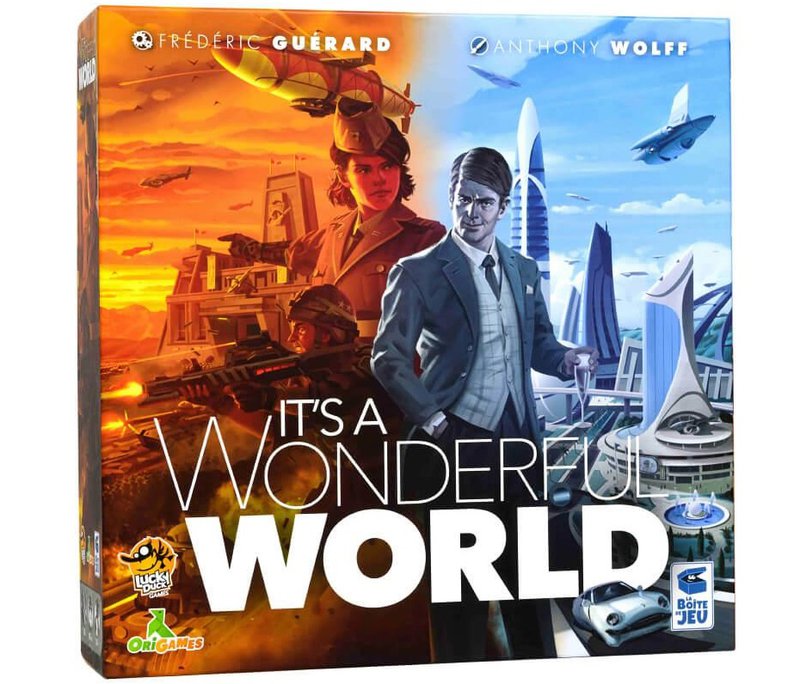
It’s A Wonderful World isn’t a heavy game, or a light one, but one that is just fun to pull out and put on the table. Some of the most fun I had was leaning into the ridiculousness of the cards. My favorite moments came when we finished games at public events, each player taking time bragging about their accomplishments. Sure, maybe they didn’t win, but their nation could now turn lead into gold and time travel. Could anyone else do that?!
In the end, I don’t care if a game is considered to be light or heavy, I don’t mind what genre a game is or what elements of tableau building or card drafting it borrows. What matters is fun, and if my many, many games of It’s A Wonderful World have anything to say, it's that I think it's still fun enough to bring to the table, dozens of games in.